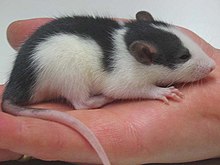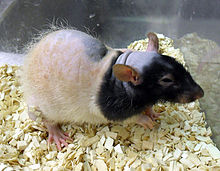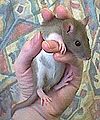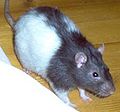Color rat
The color rat ( Rattus norvegicus forma domestica), even large mouse or a lab rat named derived from the wild brown rat and is produced by culturing the requirements as pets have been adjusted.
Domestication
Professional pied piper in the 19th century (probably before) kept captive animals in order to study their behavior and to be able to catch them better. One of the most famous rat catchers of his time, who was already selling tame animals to interested parties, was the London Jack Black . Domestication of the brown rat began around the beginning of the 20th century . Traveling circus people and showmen discovered albinos of brown rats for themselves and exhibited them. They quickly discovered that these animals and their descendants were always tamer and more peaceful than their wild ancestors. Later the animals were also bred for laboratories and laboratory animal institutes, which gave the animals the additional name "laboratory rat".
The “Wistar Institute for Anatomy and Biology” of the University of Pennsylvania, Philadelphia (USA), which began around 1906 to breed rats as “standardized” laboratory animals, became particularly important . Today they are known as so-called "Wistar rats" or "WISTARAT" and are found in many research laboratories around the world. For example, Wistar laboratory rats were used in the well-known Rat Park addiction research experiments. From 1957 to 1994 the “Central Institute for Laboratory Animal Breeding” in Germany bred rats for use in laboratories.
In the period that followed, more and more color variants emerged, which means that the cultivated form differs significantly from its wild relatives. That is why the term “color rat” became established for the domesticated animals. In breeding, attention was increasingly paid to genetic diversity. There are now clear differences in physiology (body functions), anatomy (body structure) and behavior between wild brown rats and pet rats. Therefore it is also justified to speak of an actual domestication.
features
In comparison to the brown rat, pet rats have a slightly lower weight on average. Some organs such as the heart, kidneys, adrenal glands and thyroid are also somewhat smaller. Some parts of the brain such as the corpus striatum and cerebellum are also reduced in size, while the olfactory center , for example, is almost unchanged, and the pituitary gland and thymus are even heavier. In addition, pet rats show a less aggressive, more trusting and less neophobic behavior as well as a reduced urge to move. Sexual maturity sets in them earlier, the period of fertility ( fertility ) is increased overall. Laboratory animals that are kept under "wild conditions" soon show their organ weights approximating that of wild forms.
Pet rats become sexually mature at five to six weeks of age. The gestation period is about 22 days. A litter consists of about 12 to 14 young animals on average, up to 20 and more are also possible.
attitude
The color rat was often kept by punks as a "body rat" from the 1980s onwards and is now firmly established as a pet .
Rats have a sometimes stronger, sometimes weaker urge to move. Due to the fact that rats have a convexly arched backbone, running wheels (through the movement "in the hollow back") can cause severe back damage in these animals. Therefore, in contrast to other small animals, they are not allowed to use exercise bikes , but need sufficient other possibilities of movement, namely through a sufficiently large cage and regular exercise in a rat-proof room. When purchasing a cage, it should be noted that the grid spacing must not be too large: If a rat gets its head through an opening, the rest of the body usually fits through. The height of the cage can be ample. Whole and partial levels automatically increase its usable area. In addition, rats like to watch their owner at eye level, preferably lying (often stacked) in a hammock. For these reasons, rabbit cages are usually ruled out as species-appropriate housing.
The animals are only a maximum of 2 to 3 years old, males tend to be older than females. Rats often develop mycoplasmosis , abscesses and, with advancing age, tumors. They are one of those pets that quite often require veterinary treatment, which increases the cost of their care higher than is the case with other small animals.
Pet rats, like their wild ancestors, are omnivores that feed mainly on plants.
Social behavior
Since rats are very social animals, they should never be kept individually. Mutual grooming, play and communication with conspecifics are extremely important to them. Rats clean each other often and extensively, also to clarify the hierarchy, which is called "forced cleaning". Sometimes the losing party squeals heartbreakingly. Usually, however, they communicate using tones in the ultrasonic range that are inaudible to humans . There are breeding lines in which audible noises are part of the regular behavioral repertoire even without a serious threat, which can lead to irritation when communicating with conspecifics or humans. A distinction should be made between these noises due to respiratory problems.
Rats have a very pronounced territorial behavior. Foreign animals that enter the territory of a pack are driven away or killed. This should be kept in mind when keeping rats as pets. If you want to add new animals, integration must be carried out in order to avoid injuries or deaths. The first meetings usually only last a few minutes, and it can take several weeks to work your way through to a harmonious group. The newcomers absolutely need their own cage, which ideally is in a different room than the first pack. Since you never know exactly how long the introductory phase will take, it should definitely be the recommended minimum size. The territorial behavior of the pet rat is only fully developed around the tenth week of life. So-called “baby integrations” with younger animals usually only take 2–3 hours; After this introductory phase, all young animals can move into a thoroughly cleaned cage together.
Individual keeping is only justifiable if a single animal remains due to a death and the integration of new rats fails. In this case the rat owner is called upon to spend as much time as possible with the animal, to contribute to grooming and to counteract a withdrawal of the rat through loving care and spiritual encouragement. Otherwise one has to expect depression, aggression and autoaggression in the animal.
In 2011, scientists from the University of Chicago published the results of an experiment that led them to conclude that rats display empathic- motivated behavior. They imprisoned one of two animals at a time, with the other animal having the opportunity to free the trapped animal. The free animal made use of this possibility, experimentally excluding motives other than empathic. For example, the captured animal was only freed when “locked up” chocolate was offered as an alternative, which the animal could have “freed”. In 2015, Japanese scientists published a paper in which they demonstrated that rats are able to interpret visual emotional signals from their conspecifics, warning them of dangerous situations. Rats apparently adapt their behavior to the signals of other species, from which the scientists concluded that these signals can have a communicative function.
Cultivated forms
In the meantime, an active breeding community is taking care of the continued existence of the color rat, who want to specifically reproduce certain characteristics. In the USA, for example, there is the National Fancy Rat Society, which issues exact guidelines regarding the appearance of the individual cultivated forms. This ranges from “harmless” forms (e.g. a certain coat color or a special pattern) to so-called “ torture breeds ”. It is controversial what exactly is to be classified as torture breeding, and the topic is repeatedly lively discussed in breeder and keeper circles.
Common breeds mainly focus on two areas, often combined:
- Various specific colors that have the corresponding technical names. The colors range from white to champagne and cream to gray, brown and black.
- Different patterns such as a stripe on the back and / or a different color of the head and body (so that it looks like the rat has a cap on).
A popular and widespread cultivated variant is a white body with a darker head and a stripe on the back that is as narrow as possible, but absolutely uninterrupted.
Controversial breeds (often called agony breeds) are mostly aimed at influencing the rat's physiology. Examples are:
- " Dumbo rats ": Their main characteristic is that the ears are rounded and stick out to the sides of the head instead of tapering to a point and pointing upwards. The ear canal, however, is in the same location as the standard ear-shaped rat. The namesake was Disney's cartoon elephant Dumbo , to whom this ear shape is reminiscent. This should make the rat look "cuter". Some rat experts claim that dumbos are more likely to be deaf; In addition, it is said that ear play is severely restricted, sometimes even completely impossible. Due to the slightly arched head of the breed, the neck muscle also protrudes more, which is sometimes interpreted as a bad posture (hump).
- "Rex": In this breed, the fur is not close to the skin, but slightly curled. The animals look similar to hamsters in terms of fur . The problem is that the vibrissae (whiskers) and eyelashes also curl. Since the vibrissae are important for balance and it is assumed that the curled eyelashes lead to eye infections more often, this variant is often viewed as torture breeding.
- “Naked rats”: The attempt is made to breed away the fur as much as possible, preferably completely. This also applies to the vibrissae and eyelashes. The lack of fur makes these animals more susceptible to cold and drafts, and direct sunlight can also be problematic (sunburn).
- An extreme breed that affects the physique is the form known as "tailless" (tailless). The tail, considered disgusting by many, was bred away. For the rat, however, this is an important organ that is needed for temperature regulation, helps maintain balance and is used as a kind of fifth extremity when climbing.
Color and fur drawings
- Agouti : Brown-gray fur with a reddish sheen
- Albino : white fur and red or pink eyes
- Baldie : Similar to Hooded, an animal in this drawing has a colored head with a continuous stripe down to the base of the tail, but it must also have a point (headspot) on its forehead.
- Bareback : Rats with this coat of paint only have a colored head and colored shoulders; the rest of the body is white.
- Berkshire : The animal always has a white belly, regardless of the rest of the coat color; the front paws are ideally white. The drawing on the abdomen must not run onto the paws.
- Black Eyed White : The animal is completely white with black eyes.
- Blazed Berkshire : In the ideal form, rats with this coat pattern have a blaze that tapers in a slightly triangular shape from the nose to the forehead, but narrower and crooked blazes are also permitted. The belly is white, the drawing on the flanks goes slightly upwards. The drawing must run out to all four paws; Furthermore, in the ideal shape, the end of the tail is light.
- Blazed Variegated : In this drawing, the animal has a colored head with a clear blaze, which ideally tapers towards the nose. The animal should be wildly colored over the back, but there may also be spots over the rest of the body.
- Capped : The ideal form of this drawing is that the animal has a clearly visible colored cap approximately between the ears (similar to a cap), the rest of the body is white.
- Cinnamon : Light brown, cinnamon-colored rat with different coat patterns (e.g. Berkshire)
- Headspotted Berkshire : With this fur pattern, the animal has a belly and tail pattern similar to Blazed Berkshire, only a more or less clearly visible point may be present on the forehead. It is irrelevant how big the point is, only a white hair on the forehead is permitted.
- Headspotted Variegated : Headspot and irregular blotchy back or side markings.
- Hooded : the head and shoulders are colored; From the shoulders to the base of the tail there is ideally a continuous strip. But animals with interruptions in the back stripe are still to be regarded as hooded.
- Husky : White blaze on the face that continues to the neck. The back and the flanks are colored.
- Irish : An animal with this drawing has a white spot on the chest between or just behind the front paws, whereby the size and shape of the spot can vary.
- Masked : As the English name suggests, a rat with this fur pattern must have a colored mask around the eyes; the rest of the body is white.
- Self : The animal must be completely monochrome.
- Siamese : The fur is white or beige, but the nose and ears are darker.
- Variegated : In this drawing, the head is colored with a clearly visible, more or less large, closed spot on the head. The back or the rest of the body is wildly spotted, spots may also be present on the underside.
Diseases
Pet rats can be infected by some pathogens that are unique to this species or related rat species. These include the rat coronavirus , which causes sialodacryoadenitis in pet rats . Infections with the Kilham rat virus (KRV, family Parvoviridae , species Rodent protoparvovirus 1 ) and the Sendai virus are also important. The Mycoplasmose the rat is the most common disease of the upper respiratory tract . More common ectoparasites are mites ( rat mange ), Liponyssus bacoti , lice and hair follicle mites .
Web links
- Association of rat lovers and keepers in Germany V.
- Rats as pets
- Rat information from Switzerland
- Information about keeping pet rats
Individual evidence
- ↑ Full Revelations of a professional rat-catcher by Ike Matthews on Project Gutenberg
- ^ The Wistar Institute: History ( Memento October 17, 2008 in the Internet Archive )
- ↑ Oliver Schleif: A contribution to animal-friendly keeping of rats based on the literature (PDF; 1.3 MB) p. 47 f .. Accessed on June 19, 2013.
- ↑ Ann Storey: Rat Breeding: Part 1 Biology . Archived from the original on March 18, 2013. Retrieved June 19, 2013.
- ↑ Page with current minimum requirements for cage size
- ^ Inbal Ben-Ami Bartal, Jean Decety, Peggy Mason: Empathy and Pro-Social Behavior in Rats. In: Science . Vol. 334, 2011, pp. 1427-1430, doi : 10.1126 / science.1210789 .
- ↑ SF Nakashima, M. Ukezono, H. Nishida, R. Sudo, Y. Takano: Receiving of emotional signal of pain from conspecifics in laboratory rats. In: Royal Society Open Science. 2, 2015, p. 140381, doi : 10.1098 / rsos.140381 .
- ↑ NFRS: Varieties of Fancy Rat ( Memento of December 9, 2006 in the Internet Archive )
- ↑ NFRS Standards of Excellence (guidelines on the appearance of the individual cultivated forms) ( Memento of May 18, 2008 in the Internet Archive ) (PDF; 127 kB)
- ↑ Colin Patterson: Pet rats. John Alexander Enterprises, sl 2006, ISBN 1-84728-570-8 , pp. 20-24.
- ↑ Carol Himsel Daly: Rats. Everything about Purchase, Care, Nutrition, Handling, and Behavior (= A Complete Pet Owner's Manuals ). Barron's, New York NY 2002, ISBN 978-0-7641-2012-1 , p. 14.
- ↑ Gerd Ludwig: My rat. Gräfe and Unzer, Munich 2008, ISBN 978-3-8338-1174-6 , p. 23.
- ↑ NCBI: Kilham rat virus (no rank)
- ↑ Werner Nicklas: Kilham Rat Virus (KRV) , on: gv-solas, DKFZ Heidelberg
- ↑ David G. Baker: Natural Pathogens of Laboratory Mice, Rats, and Rabbits and Their Effects on Research. In: Clinical Microbiology Reviews. Vol. 11, No. 2, 1998, ISSN 0893-8512 , pp. 231-266, (Review) PMID 9564563 , PMC 106832 (free full text).











